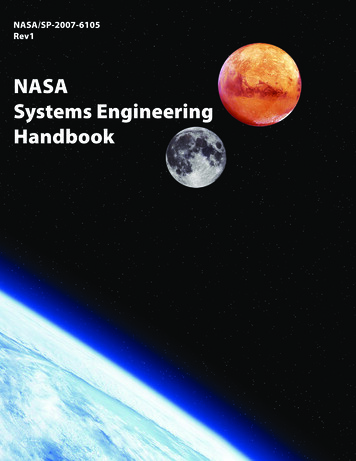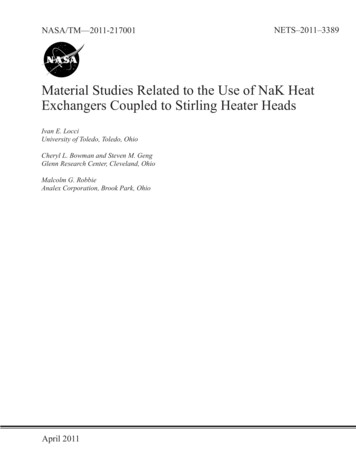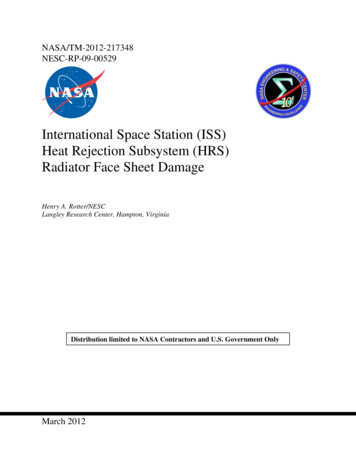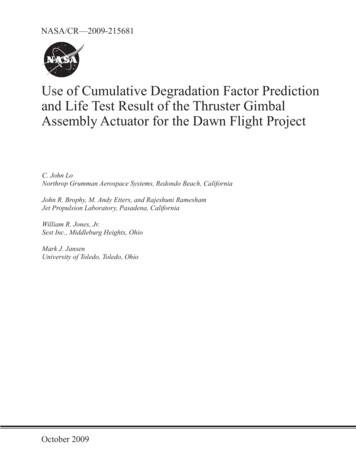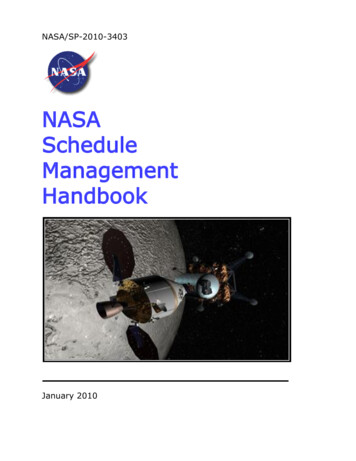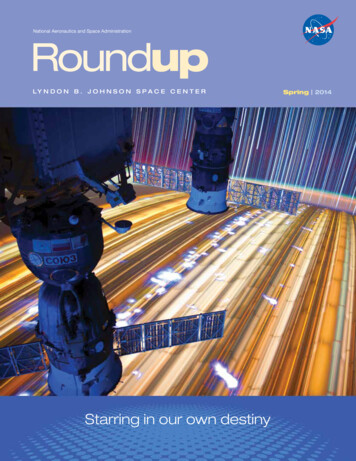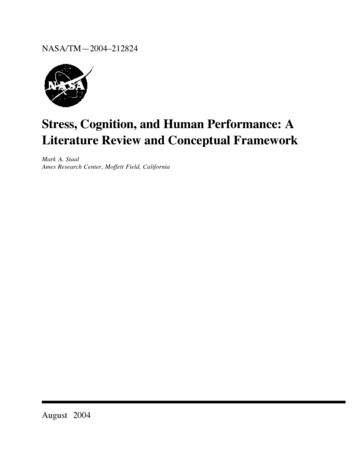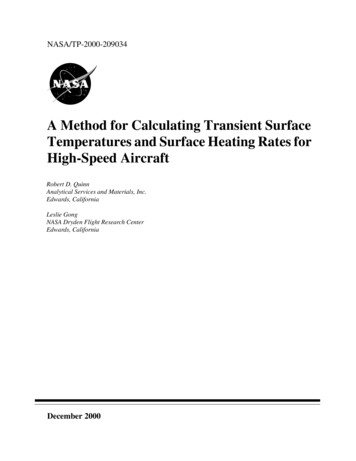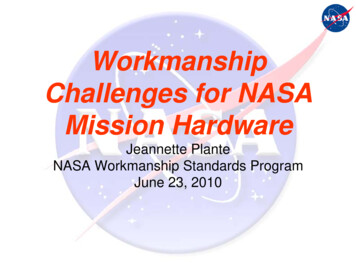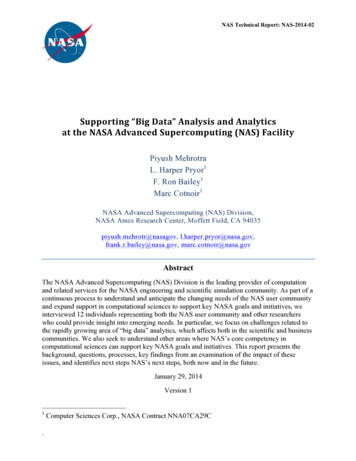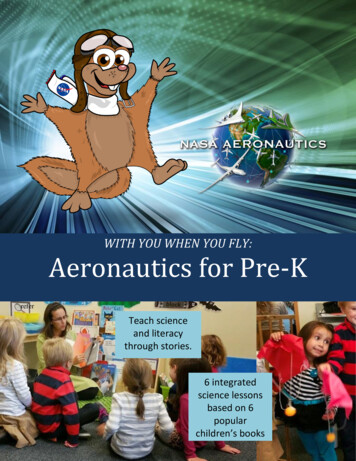
Transcription
WITH YOU WHEN YOU FLY:Aeronautics for Pre-KreferTeach scienceand literacythrough stories.6 integratedscience lessonsbased on 6popularchildren’s books1
Literature ListLesson 1: Gliders in Nature – Key Concepts: Form and FunctionThe Dandelion SeedText copyright 1997 by Joseph AnthonyIllustrations copyright 1997 by Cris ArboDawn PublicationsLesson 2: Balloons – Key Concepts: Floating and Sinking, WeightHot Air: The (Mostly) True Story of the First Hot Air Balloon RideCopyright 2005 by Marjorie PricemanAtheneum Books for Young Readers,An imprint of Simon & Schuster Children’s Publishing DivisionLesson 3: Parachutes – Key Concepts: Fluid Thickness, DragEgg DropCopyright 2009 by Mini GreyKnopf Books for Young ReadersLesson 4: Kites – Key Concepts: Area, LiftKite FestivalCopyright 2004 by Leyla TorresFarrar, Straus, and GirouxLesson 5: Airplanes and Helicopters – Key Concepts: Force, PropulsionClorinda Takes FlightText copyright 2007 by Robert KinerkIllustrations copyright 2007 by Steven KellogPaula Wiseman Books/Simon & Schuster Books For Young Readers,An imprint of Simon & Schuster Children’s Publishing DivisionLesson 6: Global Flyers – Key Concepts: Geography, InterconnectednessPlanes Fly!Text copyright 2013 by George Ella LyonIllustrations copyright 2013 by Mick WigginsAtheneum Books for Young Readers,An imprint of Simon & Schuster Children’s Publishing DivisionWith You When You FlyNASA’s Educator Resource Guide to Living in the Age of pdfSupplement your science of flight lessons with NASA’s High Flyer’sAlphabet Activity Book: http://goo.gl/GmWEml Writing Reading Math Colors/Shapes2
OverviewAeronautics for Pre-K: A Literacy Approach for ScienceAlthough most children (and adults) associate NASA with space flight, NASA’s first “A” stands for“Aeronautics.”Before the first airplane, scientists and engineers worked to develop lighter-than-air aircraft using the principleof buoyancy. They also turned to parachutes and gliders to learn to drift across air currents and slow their rate ofdescent as they fell. It is from these early beginnings that aviation and space flight have become what they aretoday. In this full unit of study for pre-school and early elementary students, we will investigate gliders innature; balloons, parachutes and kites; helicopters and airplanes; the impacts of aviation through classicchildren’s literature; and science and engineering activities.This educators’ guide provides an opportunity to teach thematic lessons on aeronautical science principlesthrough children’s literature. The guide is the result of an effort to address a growing need for early STEMeducation, and is founded on the ideas and principles provided by popular children’s books.Because a robust instructional approach is also very important, these activities are aligned with the cross-cuttingprinciples and science and engineering process skills elaborated in the Next Generation Science Standards.Many can also be easily applied or adapted to teach the Next Generation Science Standards and the CommonCore State Standards for early elementary education.3
Table of ContentsLITERATURE LIST . 2The Dandelion Seed . 2Hot Air: The (Mostly) True Story of the First Hot Air Balloon Ride . 2Egg Drop . 2Kite Festival. 2Clorinda Takes Flight . 2Planes Fly! . 2With You When You Fly . 2OVERVIEW . 3EARLY LEARNING STANDARDS FOR SCIENTIFIC INQUIRY AND PHYSICAL SCIENCE . 6GLIDERS IN NATURE . 7FOCUS STORYBOOK . 8The Dandelion Seed . 8LEARNING GOALS . 8SCIENCE/ENGINEERING: PRE-READING ACTIVITIES. 9Investigation: Flyers and Gliders in Nature . 9READING: THE DANDELION SEED .15SCIENCE/ENGINEERING: BOOK-BASED ACTIVITIES .17Discovery Learning: Seed Classification .17Interactive Demonstration: Maple Seeds .18Inquiry Experiment: Wind and Wings .18Inquiry Experiment: Paper Whirly-Birds .20WRITING: “F” AND “G” .23BALLOONS . 27FOCUS STORYBOOK .28Hot Air: The (Mostly) True Story of the First Hot Air Balloon Ride .28LEARNING GOALS .28SCIENCE/ENGINEERING: PRE-READING ACTIVITIES.29Investigation: Sinking and Floating Objects .29Interactive Demonstration: Soda and Oranges .29Application: Density Column .31Interactive Demonstration: Sensory Bottles .31Experiment: Floating Boats .31Interactive Demonstration: Salt Water .31Interactive Demonstration: Floating and Sinking Balloons.31READING: HOT AIR: THE (MOSTLY) TRUE STORY OF THE FIRST HOT AIR BALLOON .32SCIENCE/ENGINEERING: BOOK-BASED ACTIVITIES .33Experiment: Helium Balloon Activity .33Interactive Demonstration: Hot Air Balloon .35WRITING: “B” .38PARACHUTES . 43FOCUS STORYBOOK .44Egg Drop .44LEARNING GOALS .44SCIENCE/ENGINEERING: PRE-READING ACTIVITIES.45Experiment: Coffee Filters and Marbles .45READING: EGG DROP .474
SCIENCE/ENGINEERING: BOOK-BASED ACTIVITIES .48Application Lab: Parachute Building .48Interactive Demonstration: Group Parachute .49WRITE: “D” AND “U.”.50KITES . 53FOCUS STORYBOOK .54Kite Festival.54LEARNING GOALS .55SCIENCE/ENGINEERING: PRE-READING ACTIVITIES.55Inquiry Experiment: Build and Test a Simple Straw Glider .55READING: THE KITE FESTIVAL .56SCIENCE/ENGINEERING: BOOK-BASED ACTIVITIES .57Discovery Lab: Materials Science .57Application Lab: Kite Building .58Art Project: Suncatcher .62WRITING: “K” .63HELICOPTERS AND AIRPLANES . 65FOCUS STORYBOOK .66Clorinda Takes Flight .66LEARNING GOALS .67SCIENCE/ENGINEERING: PRE-READING ACTIVITIES.67“Getting On an Airplane”.67Interactive Demonstration: Gliders, Planes, and Helicopters .69SCIENCE/ENGINEERING: PRE-READING ACTIVITIES.70Inquiry Experiment: Surface Area and Lift .70Inquiry Experiment: Surface Area, Thrust, Angle, and Distance .70READING: CLORINDA TAKES FLIGHT .71SCIENCE/ENGINEERING: BOOK-BASED ACTIVITIES .72Interactive Demonstration: Aerolab .72WRITING: “H,” “J,” AND “Z.” .74WORLD FLYERS . 79FOCUS STORYBOOK .80Planes Fly! .80LEARNING GOALS .81READING: PLANES FLY! .81SCIENCE/ENGINEERING: BOOK-BASED ACTIVITIES .81Application Activity: Air Cargo .81Inquiry Lab: Round Globe, Flat Map .86WRITING “A,” AND “P,” AND “T.” .88ADDITIONAL INFORMATION AND EDUCATOR RESOURCES . 92WITH YOU WHEN YOU FLY .935
Early Learning Standards for Scientific Inquiry and Physical ScienceThis document was created with the National Science Teachers Association (NSTA) Position Statement: EarlyChildhood Science Education in mind. To access the full document, please ldhood.aspx The NSTA position statement emphasizes that evenvery young children are capable of learning fundamental scientific concepts and practices. The primaryapproach to teaching science should encourage inquiry, hands-on activities, and play.Many of the scientific investigations in this guide can also support Common Core State Standards Englishlanguage arts and math literacy that children need to develop throughout their school years:http://www.corestandards.org/Through the activities in this guide, children learn about fundamental physical concepts, as well as becomeintroduced to many of the science and engineering practices listed in the Next Generation Science Standards:http://www.nextgenscience.org/6
Lesson 1Gliders in Nature7
LessonGliders inNatureLiteratureThe DandelionSeedKey Q’sWhat kinds of things flyor glide? What makesthem able to fly orglide? Why is it good tobe able to fly or glide?Primary MaterialsImages of animals andplant seeds that fly/glide.Maple seeds (fresh ordry, enough for eachstudent to have 2-3).Seed samples –multiple examples ofseeds that glide (maple,elm, dandelion,milkweed, etc.) andseeds that don’t(coconut, acorns,hitchhikers, seedsfound in fleshy fruits,etc.)Whirly-bird templatePaper ClipsScissorsCrepe/streamersResourcesHigh Flyers e-BookLesson 1: Gliders in NatureBirds fly, and so do some small mammals. However, a much larger number oforganisms, including plant seeds, glide. In this module, children will first comparecommon seeds that glide, and determine what physical characteristics make themgood gliders, as well as why gliding is advantageous. Children will then be read TheDandelion Seed to categorize seeds within the book as gliders or non-gliders basedupon their physical characteristics. These concepts help prepare young students tounderstand form and function. By learning about the characteristics of a goodglider, children will also learn how humans have long attempted to fly by copyingideas from nature, often referred to as biomimicry.Focus StorybookThe Dandelion SeedBy Joseph Anthony, illustrated by Cris ArboCopyright 1997 by Joseph Anthony and Cris ArboUsed with permissions of the author and illustratorDawn PublicationsLearning GoalsLanguageMathScience/ Engineering Vocabulary: Fly, Glide.Writing: Write “F” and “G.”Count the twists as a paper “seed” glides down.Measure distance of a blown seed (near/far).Explain what characteristics make for a good glider,and why gliding is important (biology).Design a seed that takes the longest time to fall(physics).8
Fine Motor Skills Cut a straight line.Science/Engineering: Pre-Reading ActivitiesInvestigation: Flyers and Gliders in NaturePerhaps one of the best examples of the intersection between biology and engineering to which small childrencan relate is the study of flight. Children’s books often focus on topics such as plants and animals and thingsthat “go” (i.e. cars, trucks, and planes), but the relationship between these topics is often overlooked.1. Begin a discussion of flight by helping students to identify some flyers in nature. Children will most likelythink of: Birds Insects (butterflies, bees, etc.) BatsHowever, not all things that travel by air actually fly. Generally, flyers power their own motion (typically byflapping), while gliders simply let themselves be carried by the wind. Gliders include a variety of seeds that getdispersed by the wind, baby spiders that “balloon” away from their place of birth, and many fish, mollusks,amphibians, and mammals that use gliding to stay aloft when jumping, or to slow themselves down as they fall.2. Provide students with books and printed/projected images of animals that fly or glide, and those that do not(see the following pages for images).3. Discuss how flyers and gliders look. They have wings (flyers/gliders), or extra skin that acts as a parachute (gliders). They have big wings for their size. They have thin (aerodynamic) bodies.4. Discuss why it might be beneficial to animals and plants to be able to fly or glide. It is faster than walking. It is easier to get away from danger. It is easier to cross forests/rivers/oceans/mountains, etc. It allows animals to have access to a much larger area for food and shelter. It allows plant seeds to get spread over a much larger area so that they have a better chance of survivaland reproduction.
Birds that Fly/GlideBald Eagle, Photo Credit: USFWSMallard Duck, Photo Credit: USFWS
Birds that DO NOT GlidePenguins, Photo Credit: NSFAttwater’s Prairie Chicken, Photo Credit: USFWS
Other Gliding AnimalsFlying Fish, Photo Credit: NOAAMexican Long-Tongued Bat, Photo Credit: USFWSWest Virginia Northern Flying Squirrel, Photos Credits: USFWS
Some examples of flyers and gliders include: Birds (most) - FLYING Mammals (some)o Gliding squirrel (as can be seen in NASA Aeronautics’ mascot!) – GLIDINGo Possums – GLIDINGo Lemurs - GLIDINGo Bats - FLYING Amphibians (some) – Flying frog – GLIDING Reptiles (some)o Lizards – GLIDINGo Geckos – GLIDING Fish (some) – Flying fish - GLIDING Mollusks (some) – Flying squid - GLIDING Arthropods (most)o Insects – FLYINGo Spiders – BALLOONING Pterosaurs (extinct) – FLYINGAlthough birds are often the first thing children think about when asked what kinds of animals fly, not all birdsare capable of flying or gliding. After discussing what makes an animal a good glider, ask students to look at avariety of images of birds that can and can’t fly, to see if they all have the traits necessary for gliding. Considerlooking at the following:o Birds – Look at bird feathers or images of different types. See some examples you might want todiscuss below: Which kinds of birds glide? Eagle – YES Chicken – NO Duck – YES Ostrich – NO Penguin - NO What is the difference between birds that glide/fly and birds that don’t? Gliders typically have streamlined bodies and large wings for their weight. Thesebirds tend to need to fly long distances without stopping (migratory birds, seabirds). Non-gliders do not necessarily have streamlined bodies or large wings. Thesebirds are often land-bound, and are able to eat their prey and protect themselveswithout the need for flight.
Color Orville the Flying Squirrel, NASA Aeronautics’ new mascot!Like most other squirrels, flying squirrels live high up in the treetops. What is the benefit ofhaving the extra skin between a flying squirrel’s arms and legs?Although they are called flying squirrels, do flying squirrels actually fly? Explain!
For a long time, people tried to FLY by making machines or outfits that they hoped people would be able to useto flap. However, gliding is much easier than powered flying.The first people to really be successful at building airplanesfirst made sure that they understood how to GLIDE beforethey tried to FLY.Although gliding and flying are what people have longwanted to do simply because they are fascinated by both,there is a really important reason for flight – because oftravel! In the same way, plant species are most successful atsurviving if they can spread their seeds all over, using thewind to disperse.Reading: The Dandelion SeedBy Joseph Anthony, illustrated by Cris ArboCopyright 1997 by Joseph Anthony and Cris ArboUsed with permissions of the author and illustratorDawn PublicationsRead The Dandelion Seed, a book about the lifecycle ofdandelions, from seed to flower to seed. The focus is on thejourney the seed can make because of the force of the windand the tufts that make it glide across the land. As you read,consider using the following strategies to engage thelisteners: Joseph Patrick Anthony and Cris Arbo Why would a dandelion plant want its seeds to be carried by the wind? What makes a dandelion seed really good at being“caught” by the wind and being blown about?o It is very lighto It has “feather-like” designs What would happen to the seed if the weather wasbad? (It might get blown really far away, or it mightget wet and not fly at all).Figure 1: The Dandelion Seed, page 32 Joseph Patrick Anthony and Cris Arbo
What other seeds can be found in the pictures in the book? Have students find at least three other seeds!Figure 3: The Dandelion Seed, pg. 12 Joseph Patrick Anthony and Cris ArboFigure 2: The Dandelion Seed, pg. 5 Joseph Patrick Anthony and Cris Arbo Are the other seeds found in the pictures in the book gliders, or are theynot gliders? How do you know?Figure 2: These are examples of plants that dry up before releasing theirseeds. The seed capsules either burst and release the seeds, or the seedssimply drop. These seeds ARE NOT gliders.Figure 3: These grass seeds have “feather-like” ends, much like thedandelion seeds. These seeds ARE gliders!Figure 4: Acorns are fairly heavy, and the wind cannot blow these seedsaround. This seed IS NOT a glider. Dandelion seeds glide really well. Do airplanes look like dandelionseeds? What is similar? What is different? (Remind students thatairplanes FLY with engines or propellers that can take them where theywant to go, and that they only sometimes GLIDE. A gliding seed getspushed around wherever the wind takes it). Figure 4: The Dandelion Seed,pg. 20 Joseph Patrick Anthony andCris ArboWhat happens to gliding seeds when the weather gets bad? How do you think weather affects airplaneflight? (Because airplanes don’t want to get pushed around – they might end up in the wrong place –airplanes usually won’t fly in really bad weather).
Science/Engineering: Book-Based Activities
can relate is the study of flight. Children’s books often focus on topics such as plants and animals and things that “go” (i.e. cars, trucks, and planes), but the relationship between these topics is often overlooked. 1. Begin a discussion of flight by helping students to . i. dentify s
